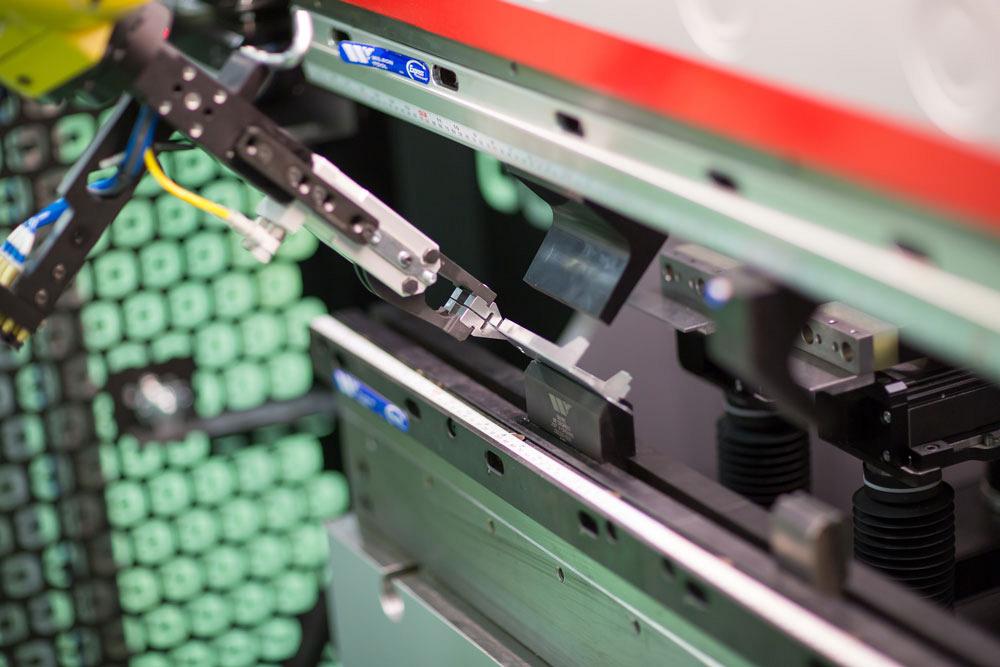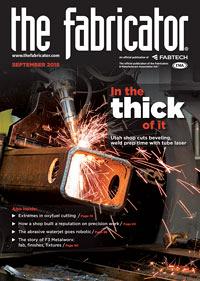Fabrication Segment Manager
- FMA
- The Fabricator
- FABTECH
- Canadian Metalworking
Categories
- Additive Manufacturing
- Aluminum Welding
- Arc Welding
- Assembly and Joining
- Automation and Robotics
- Bending and Forming
- Consumables
- Cutting and Weld Prep
- Electric Vehicles
- En Español
- Finishing
- Hydroforming
- Laser Cutting
- Laser Welding
- Machining
- Manufacturing Software
- Materials Handling
- Metals/Materials
- Oxyfuel Cutting
- Plasma Cutting
- Power Tools
- Punching and Other Holemaking
- Roll Forming
- Safety
- Sawing
- Shearing
- Shop Management
- Testing and Measuring
- Tube and Pipe Fabrication
- Tube and Pipe Production
- Waterjet Cutting
Industry Directory
Webcasts
Podcasts
FAB 40
Advertise
Subscribe
Account Login
Search
3 signs that it’s time to automate the press brake
If a shop has issues with press brake productivity, keeping good workers, and producing consistent parts, it might want to consider robotic bending
- By Chris Poole
- September 6, 2018
- Article
- Bending and Forming

Figure 1
Robotic bending cells are becoming increasingly popular, even in job shop environments. The inability to find experienced press brake operators and to keep up with faster laser cutting technologies has fueled this trend.
Press brake forming is one of the most common operations in metal fabrication. It can involve bending 20-foot sections of heavy plate or making 0.25-inch flanges on a small piece of thin-gauge sheet metal. Everyone does it.
Manual press brake operation can be effective for many of these bending applications, but there are several signs that a new approach may be called for. Let’s look at the three signs that indicate robotic automation is a better way to bend metal.
Sign 1: The Press Brake Sits Idle
The adage in metal fabricating is a press brake only makes money when its ram is moving. With that in mind, it’s easy for a fabricator to see an idle press brake as lost potential for profit.
Every company has its own threshold for accepting idle equipment, but is there really a good excuse for a press brake to sit idle? For example, if multiple operators wait in line to use the press brake during one shift, but then it sits unused at other times, that bending operation could benefit from extra effort in job scheduling to balance the load.
Adding a robotic system to a press brake application better balances utilization throughout the shop because production is more predictable and can be scheduled for maximum productivity. A robot operates at the same rate throughout an entire shift (or more than one shift), so the exact number of parts completed is consistent. Compare that to a manual operation in which even the best worker needs breaks throughout the day and progressively tires and slows down toward the end of a shift. With better scheduling, a robot can allow for additional press brake shifts, even the potential for lights-out overnight operation if the system is properly equipped.
Programming the robot offline allows more overall time for the brake to stay in operation making parts. The motions and tasks are simulated in the offline, virtual environment on the PC at the programmer’s desk. When these programs are proven in the virtual cell, the brake operator barely needs to modify the programs as they are introduced to the shop floor. This is the opposite of expectations from anyone who programmed robotic press brake operations before the advent of today’s software tools. Back then, robot programmers had to physically teach all of the robot’s paths, functions, and stopping points using a pendant control. That process would tie up a cell for days or weeks instead of the minutes or hours required to program in modern bending cells.
Autonomous changeover and job setup capabilities tear down the walls that prevented consideration of robotic forming for short-run or high-mix jobs (see Figure 1). While the robotic press brake is actively making parts (and money), offline programming software can set up optimized paths and nearly complete positioning calculated in the virtual environment. “Onesie-twosie” orders previously not considered feasible with a robotic press brake because of time-intensive setup now are viable, if the jobs are repeated over time.
Sign 2: It´s Diff icult to Keep Good Workers
It’s a fact of life: The labor shortage has created a worker’s market. Fabricators are poaching each other’s workers, and some laborers job-hop to follow the best pay. With such fierce competition for labor, workers are more comfortable with walking off a job and starting another one. Even a small increase in pay can be enough incentive to switch employers.
If a metal fabricator wants to avoid being compared to other shops solely on the basis of hourly wages, the company needs to differentiate itself from other fabricators in the area. The shop needs to make itself more appealing for workers, making it a difficult decision if another competitor offers a slight raise.
Modernizing the bending department can be one way to do that. Manually loading and unloading a press brake for hours is tedious and mind-numbing. Adding a robot to a press brake allows the fab shop to move employees to more satisfying jobs, rather than the repetitive work often associated with standing in front of a brake. Skilled operators can be tasked with more challenging setup and programming work, even assisting engineers in the design of parts, instead of performing dull press brake tasks. Additionally, positions for programming and managing robotic forming cells naturally attract a group with higher skill sets.

Figure 2
The best way to eliminate pinching hazards in small part bending on a press brake is to eliminate the need for a brake operator. Robots can step in and handle those small parts.
Also, operating a press brake can be dangerous. Parts can be very heavy, with some weighing hundreds of pounds, and large or unwieldy to lift, even with mechanical assistance. Repetitive motion and twisting involved with the loading/unloading of these heavy and large workpieces can lead to operator injuries, which result in sick time and medical pay. The press brake has the potential to cause significant injuries if the operator is not engaged in the work.
Of course, injuries aren’t limited to just large parts. Small part bending can lead to pinched fingers and even amputations (see Figure 2). That’s why some fab shops are issuing the edict “No hands near the press brake tools” for fast-moving jobs. Today’s safety devices are more advanced but will always, by their nature, have a negative effect on throughput. Most fabricators understand that such a sweeping request to have hands totally away from the press brake’s bending window is not really practical.
By putting a robot on the more dangerous, repetitive, and awkward movements associated with operating a press brake, workers are less likely to leave because they feel like they are risking injury just by doing their job.
Sign 3: Downstream, Parts Require Adjustments or Get Scrapped
Walking through a fab shop, a visitor is likely to see an operator hitting a part with a hammer or otherwise forcing it fit into a tooling fixture. After dealing with these types of issues long enough, workers might just accept this step is a natural part of the job when, in fact, it’s an indication of inconsistent part quality that can be prevented at the press brake.
How does this happen? The most experienced press brake operator is able to turn out consistent parts over a short duration of time, just like a robot, but over a longer period, fatigue, distraction, and mistakes can have an impact on a human’s ability to be consistent. In other instances, an operator might make a slight adjustment to a press brake, which can result in parts that are slightly off from specifications. Even a difference of thousandths of an inch can create part inconsistency problems.
Inconsistent parts, in turn, cause problems downstream. At assembly, misaligned parts might require extra work to make them fit. In the case of welding, additional time for weld cleanup might be required to improve the appearance of a gap-filling weld. Other parts that are not bent properly may need to be scrapped altogether.
Because of these part inconsistencies, a shop might need to invest in measurement equipment and use an operator’s time to inspect parts for consistency. Overall, inconsistent parts can result in profit-burning downtime and wasteful scrap.
Robots are programmed to make parts consistently accurate, so parts fit easily into fixtures and don’t need extra finagling during assembly. In addition, corrective, inspection, and quality control functions sometimes can be integrated into a robot cell’s operations. Simple angle and flange inspection devices in the cell’s operation are relatively inexpensive.
It’s easy to become complacent about the daily challenges in a fabrication shop. Sometimes it takes an outsider’s perspective to see the need for change. An automation consultant can analyze an operation and determine where a robot can improve press brake operations by increasing machine utilization, improving the worker experience, and ensuring part quality and consistency.
Chris Poole is segment manager, fabrication, Acieta LLC, N25 W23790 Commerce Circle, Suite F, Waukesha, WI 53188, 262-953-6200, www.acieta.com.
About the Author
Related Companies
subscribe now

The Fabricator is North America's leading magazine for the metal forming and fabricating industry. The magazine delivers the news, technical articles, and case histories that enable fabricators to do their jobs more efficiently. The Fabricator has served the industry since 1970.
start your free subscription- Stay connected from anywhere

Easily access valuable industry resources now with full access to the digital edition of The Fabricator.

Easily access valuable industry resources now with full access to the digital edition of The Welder.

Easily access valuable industry resources now with full access to the digital edition of The Tube and Pipe Journal.
- Podcasting
- Podcast:
- The Fabricator Podcast
- Published:
- 04/16/2024
- Running Time:
- 63:29
In this episode of The Fabricator Podcast, Caleb Chamberlain, co-founder and CEO of OSH Cut, discusses his company’s...
- Trending Articles
AI, machine learning, and the future of metal fabrication

Employee ownership: The best way to ensure engagement

Steel industry reacts to Nucor’s new weekly published HRC price

How to set a press brake backgauge manually

Capturing, recording equipment inspection data for FMEA

- Industry Events
16th Annual Safety Conference
- April 30 - May 1, 2024
- Elgin,
Pipe and Tube Conference
- May 21 - 22, 2024
- Omaha, NE
World-Class Roll Forming Workshop
- June 5 - 6, 2024
- Louisville, KY
Advanced Laser Application Workshop
- June 25 - 27, 2024
- Novi, MI


























